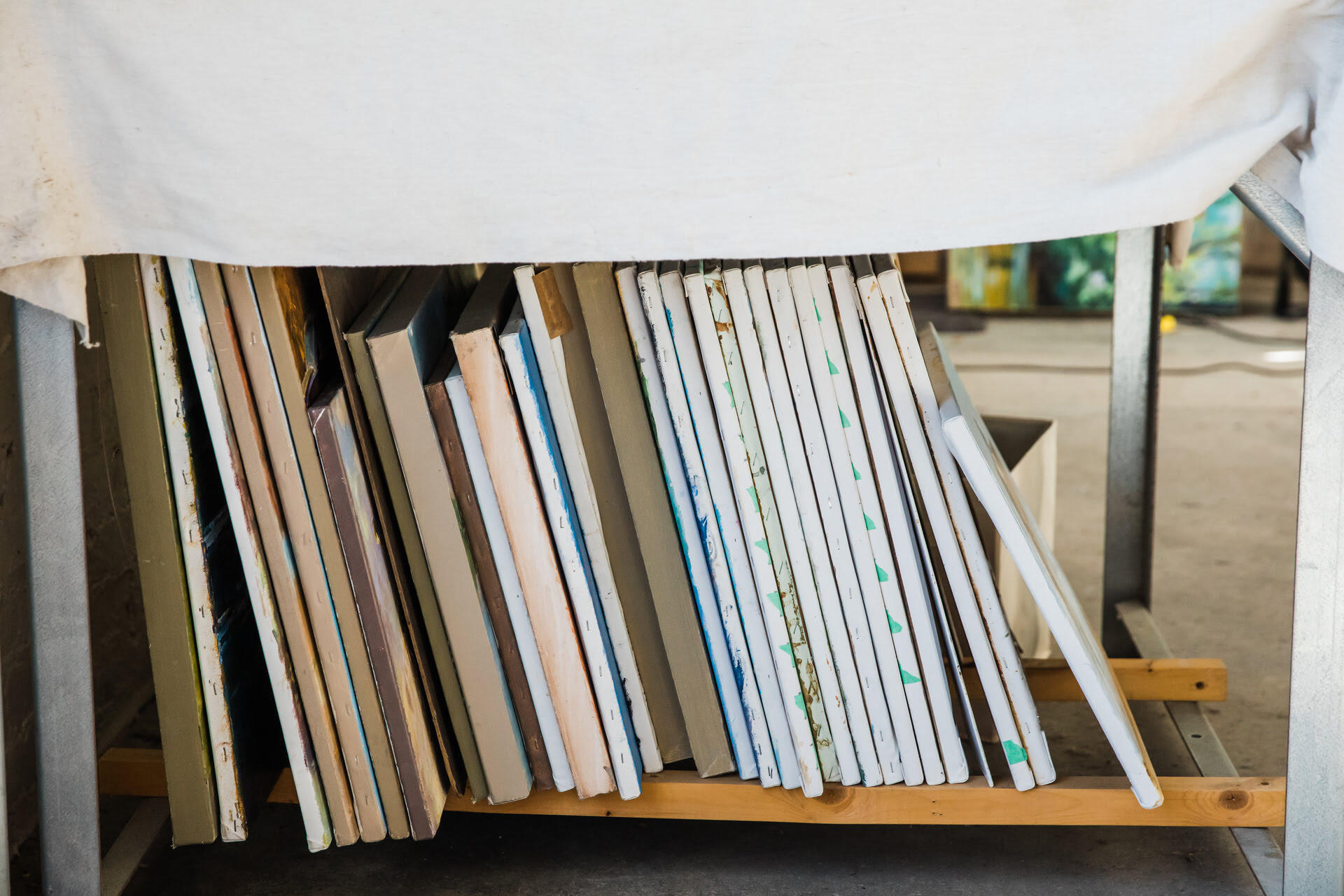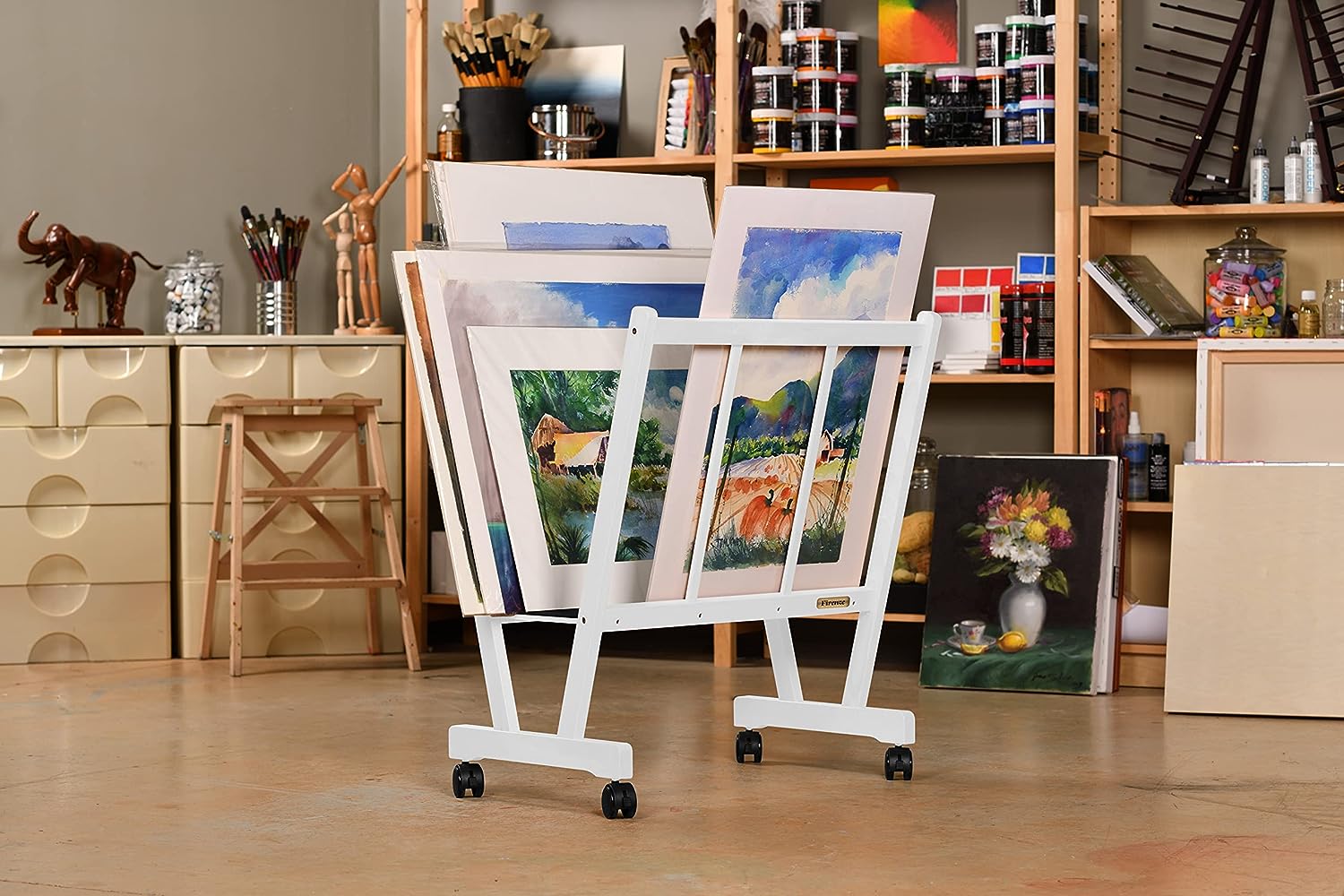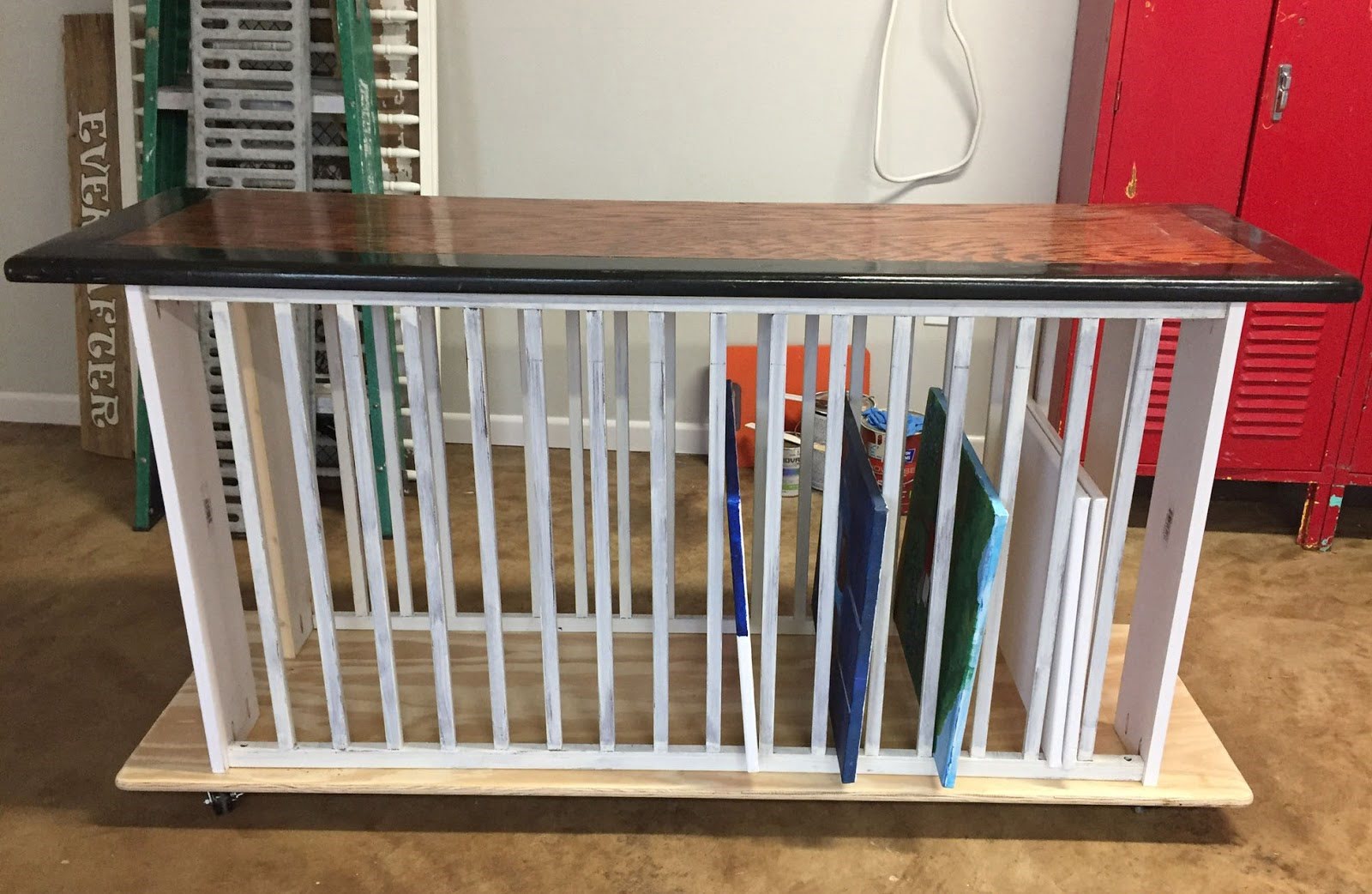

Articles
How To Store Large Canvas Paintings
Modified: March 19, 2024
Learn the proper way to store large canvas paintings with these helpful articles. Protect your valuable artwork from damage and preserve its beauty for years to come.
(Many of the links in this article redirect to a specific reviewed product. Your purchase of these products through affiliate links helps to generate commission for Storables.com, at no extra cost. Learn more)
Introduction
Welcome to the world of art! As an artist or art enthusiast, you know the value and beauty that large canvas paintings bring. These captivating masterpieces not only reflect your creative prowess but also hold sentimental and monetary value. Preserving and protecting these artworks is of utmost importance to ensure their longevity and continued enjoyment.
One crucial aspect of caring for large canvas paintings is proper storage. Whether you are a professional artist with a studio full of masterpieces or an art collector with a growing collection, having the right storage space and following correct storage techniques is essential.
In this article, we will guide you through the process of storing large canvas paintings to ensure their safety and preservation. We will cover topics such as choosing the right storage space, preparing the canvas for storage, handling and transporting the artworks, wrapping and protecting the paintings, storing them properly, monitoring and maintaining the storage environment, and retrieving and unpacking the artworks when needed.
By following these guidelines, you can rest assured that your valuable large canvas paintings will remain in excellent condition, free from damage caused by improper storage techniques, temperature fluctuations, humidity, or other environmental factors that could potentially harm them.
So, let’s dive into this comprehensive guide on how to store large canvas paintings and embark on a journey to ensure the longevity and beauty of your artistic treasures!
Key Takeaways:
- Proper storage of large canvas paintings requires careful selection of storage space, thorough preparation, gentle handling, and monitoring of environmental conditions to ensure their long-term preservation and protection.
- By following proper storage techniques, including choosing the right storage space, preparing the canvas, handling with care, and monitoring the storage environment, you can safeguard your valuable large canvas paintings and ensure their beauty and longevity for years to come.
Read more: How To Store Canvas Paintings
Choosing the Right Storage Space
When it comes to storing large canvas paintings, choosing the right storage space is crucial. The environment in which paintings are stored plays a significant role in preserving their integrity and longevity. Here are some factors to consider when selecting an appropriate storage space:
- Temperature and Humidity: Ideally, the storage space should have consistent temperature and humidity levels. Extreme fluctuations in temperature and humidity can cause damage to the canvas, paint, and other materials. Aim for a temperature between 65-75 degrees Fahrenheit (18-24 degrees Celsius) and a humidity level between 40-50 percent. Avoid spaces that are prone to moisture buildup, such as basements or attics.
- Natural Light and UV Protection: Sunlight and ultraviolet (UV) rays can cause fading and discoloration to the paintings over time. Choose a storage area that is away from direct sunlight or install UV-protective window coverings to shield the artworks from harmful rays.
- Clean and Dust-Free: Ensure that the storage space is clean and free from dust, dirt, and debris. Regular cleaning and dusting of the storage area will help prevent any build-up that could potentially harm the artwork.
- Security: The storage space should have adequate security measures in place to protect your valuable artworks. Consider factors such as surveillance cameras, alarms, restricted access, and fire safety protocols to safeguard your paintings.
- Space and Size: Evaluate the size and layout of the storage space to ensure it can accommodate your large canvas paintings. The area should provide enough room to store the artworks without them being cramped or susceptible to accidental damage.
When considering storage options, you can choose between professional art storage facilities, dedicated art storage rooms within your own premises, or custom-built storage cabinets. Professional art storage facilities offer controlled environments specifically designed for artwork storage, with climate control, security measures, and dedicated staff to ensure optimal preservation. If you decide to store the artworks within your own premises, make sure to create a designated storage area with the right conditions and take necessary precautions to protect the paintings.
By carefully selecting a storage space that meets these criteria, you can provide a secure and optimal environment for your large canvas paintings, minimizing the risk of damage and preserving their beauty for years to come.
Preparing the Canvas for Storage
Before storing your large canvas paintings, it’s important to properly prepare them to ensure their protection during the storage period. The following steps will help safeguard your artworks and minimize the risk of damage:
- Clean the Surface: Begin by gently cleaning the surface of the canvas to remove any dust, dirt, or debris. Use a soft, lint-free cloth or a delicate brush to carefully wipe away any particles. Avoid using water or harsh cleaning agents, as they can damage the paint or canvas.
- Inspect for Damage: Thoroughly inspect the artwork for any signs of damage, such as loose paint or tears in the canvas. If you come across any issues, it is recommended to consult a professional art restorer before proceeding with the storage process.
- Remove Hanging Hardware: Take off any hanging hardware, such as hooks or wires, from the back of the canvas. This will help prevent any potential damage during storage and ensure a smoother fit within the storage space.
- Apply Protective Layers: To offer an additional layer of protection to the canvas, consider applying a protective covering. Acid-free archival paper can be placed over the front of the painting, secured with archival tape, to help prevent any accidental scratches or smudges. Be sure to avoid any direct contact between the paper and the painted surface.
- Add Support: For larger canvases, it may be beneficial to add additional support to prevent warping or stress on the canvas. This can be achieved by inserting wooden or foam supports behind the canvas or by using corner protectors specifically designed for artwork.
- Document and Photograph: Before storing your paintings, it is recommended to document them by taking detailed photographs and noting down essential information such as the title, artist, dimensions, and any other relevant details. This documentation will be valuable for insurance purposes or in case of any unfortunate incidents.
By following these steps, you can ensure that your large canvas paintings are well-prepared for storage, minimizing the risk of damage and fostering their long-term preservation. Remember to handle the artworks with care throughout the preparation process, using gloves and gentle techniques to avoid any accidental harm.
Handling and Transporting Large Canvas Paintings
When it comes to handling and transporting large canvas paintings, it is crucial to take the necessary precautions to prevent any potential damages. Follow these guidelines to ensure the safe transit of your valuable artworks:
- Use Proper Handling Techniques: Always handle the paintings with clean hands or wear cotton gloves to avoid transferring oils or dirt onto the canvas. Hold the artwork by the sides or with both hands, supporting the bottom to distribute the weight evenly and prevent any strain on the canvas. Avoid touching the front of the painting to prevent smudges or accidental damage to the paint.
- Protect with Acid-Free Sheets: Place acid-free archival paper or glassine sheets over the front of the painting to protect it from any potential scratches or smudges during transport. Secure the paper with archival tape, making sure it does not come into direct contact with the painted surface.
- Secure the Painting: If the painting has a frame, ensure that it is securely attached and that any hanging wires or hooks are properly fastened. For unframed canvases, use acid-free cardboard or foam boards to provide support and protect the artwork.
- Use Proper Packaging Materials: Wrap the painting in acid-free tissue paper or bubble wrap to provide an additional layer of protection. Make sure the packaging materials are clean and free from debris. Place the artwork in a sturdy, appropriately-sized cardboard box or wooden crate that allows for a snug fit without any movement inside.
- Label and Document: Clearly label the package with information such as fragile, handle with care, and the direction of the artwork (if applicable). Document the packaging process with photographs to ensure you have a record of how the artwork was packaged for reference in case of any issues during transit.
- Transportation: During transportation, be mindful of the surrounding environment and make sure the artwork is kept in an upright position to avoid any unnecessary pressure or stress on the canvas. If possible, avoid extreme temperature conditions or exposure to direct sunlight. Consider using a trusted art transportation service if the artwork requires long-distance or international travel.
By following these guidelines, you can handle and transport your large canvas paintings with care and minimize the risk of any mishaps or damage. Remember, it’s crucial to prioritize the safety and preservation of your valuable artworks throughout the entire process.
Wrapping and Protecting the Painting
When it comes to storing large canvas paintings, wrapping and protecting them properly is essential to ensure their safety and prevent any damage. Follow these guidelines to wrap and protect your valuable artworks:
- Prepare the Surface: Ensure that the storage area is clean and free from any dust or debris. A clean environment will help protect the painting from potential scratches or smudges.
- Wrap with Acid-Free Materials: Start by wrapping the painting in acid-free archival paper or glassine. These materials are suitable for protecting the artwork and will prevent any direct contact with other storage materials or the packaging itself.
- Add Padding: Place a layer of bubble wrap or foam padding over the wrapped painting to provide cushioning and protection against impact. Make sure the padding is secure but not too tight, allowing the artwork to breathe and maintaining its shape.
- Frame Protection: If the painting has a frame, protect it by wrapping it with extra bubble wrap or foam. Secure the wrap with tape, ensuring not to apply excessive pressure or damage the frame in the process.
- Consider a Sturdy Outer Packaging: Once the painting is wrapped and padded, place it in a sturdy cardboard box or a wooden crate for added protection during storage. Make sure the box or crate is large enough to accommodate the artwork without squeezing or stressing the canvas.
- Label and Document: Clearly label the packaging with information such as the name of the painting, artist, and any handling instructions. You may also include information on the orientation or fragility of the artwork. Additionally, document the packaging process by taking photographs to serve as a reference when retrieving the painting in the future.
- Store Vertically: When storing the wrapped painting, it is generally advised to keep it in an upright position, with the painted surface facing inward to minimize the risk of damage. If stacking multiple artworks, place a protective layer, such as foam or cardboard, between each painting to prevent any friction or potential harm.
- Create a Climate-Controlled Environment: To ensure optimal preservation, it is advisable to store the wrapped paintings in a climate-controlled storage space with consistent temperature and humidity levels. This will help prevent any deterioration, moisture buildup, or mold growth on the canvas.
By following these guidelines for wrapping and protecting your large canvas paintings, you can safeguard them from potential damage during storage and ensure their long-term preservation. Remember, each artwork is unique, so it’s essential to assess the specific needs and requirements of each painting before implementing these steps.
Store large canvas paintings vertically to prevent warping and damage. Use acid-free paper or bubble wrap to protect the surface, and store in a cool, dry place away from direct sunlight.
Read more: How To Store Canvas Paintings At Home
Storing the Painting Properly
Proper storage of large canvas paintings is crucial to ensure their long-term preservation and protection. Follow these guidelines to store your valuable artworks properly:
- Select an Appropriate Storage Area: Choose a storage area that meets the requirements of temperature, humidity, and cleanliness discussed earlier. Ideally, the storage space should provide a stable environment to prevent damage caused by fluctuations in these factors.
- Position the Painting Carefully: When placing the wrapped painting in the storage space, ensure it is positioned upright and vertical, with the painted surface facing inward. This reduces the risk of any pressure or stress on the canvas.
- Allow Sufficient Space: Ensure that there is enough space between each stored painting to avoid any accidental contact or damage. It is advisable to place a protective layer, such as foam or cardboard, between each artwork as an extra precaution.
- Consider Shelving or Storage Racks: Storing the paintings on sturdy shelves or storage racks can help keep them organized and easily accessible. Make sure these storage solutions are designed for artwork and provide adequate support without causing any bending or warping of the canvas.
- Avoid Floor Storage: Whenever possible, avoid storing the paintings directly on the floor. The floor can be prone to temperature and humidity fluctuations, increasing the risk of damage to the artworks. If floor storage is the only option, elevate the paintings using pallets or wooden blocks.
- Regularly Check and Inspect: Periodically inspect the stored paintings to ensure that there are no signs of damage, such as mold growth, pests, or deterioration. A regular check-up will help you identify any issues early and take necessary measures to prevent further damage.
- Implement Security Measures: To protect your stored artworks, consider implementing security measures such as surveillance cameras, restricted access, and alarm systems. These precautions will help ensure the safety of your valuable paintings.
- Maintain an Inventory: Keep a detailed inventory of all the paintings you have stored, including their titles, artists, dimensions, and storage location. This inventory will help you keep track of your collection and locate specific artworks when needed.
By following these guidelines, you can store your large canvas paintings in a safe and organized manner, allowing for their long-term preservation and easy retrieval. Remember, proper storage techniques are essential for maintaining the integrity and beauty of your valuable artworks.
Monitoring and Maintaining the Storage Environment
Monitoring and maintaining the storage environment is crucial for the proper preservation of your large canvas paintings. By following these guidelines, you can ensure that the storage conditions remain optimal:
- Regularly Monitor Temperature and Humidity: Use a digital thermometer and hygrometer to regularly monitor the temperature and humidity levels in the storage area. Aim to maintain a consistent temperature between 65-75 degrees Fahrenheit (18-24 degrees Celsius) and a relative humidity of 40-50%. Fluctuations outside of these ranges can lead to damage to the artwork.
- Use Climate Control Systems: If necessary, consider installing HVAC systems or dehumidifiers to regulate the temperature and humidity levels in the storage area. These systems will help maintain a stable environment for your paintings.
- Prevent Exposure to Light: Light, especially direct sunlight and ultraviolet (UV) rays, can cause damage to the artworks. Ensure that the storage space is equipped with proper window coverings or use UV-protective film on windows to block out harmful rays.
- Inspect for Pests: Regularly check for signs of pests such as insects, rodents, or mold in the storage area. Implement preventive measures such as sealing cracks or gaps, using pest control treatments, and keeping the storage area clean to prevent infestations.
- Keep the Storage Area Clean: Regularly clean the storage area to remove any dust, dirt, or debris that can potentially harm the paintings. Use a soft, lint-free cloth or a vacuum cleaner with a brush attachment to gently clean the surfaces.
- Avoid Chemicals and Hazards: Keep the storage space free from chemicals, paints, solvents, or any other hazardous materials that can emit fumes or cause damage to the artworks. These substances can lead to discoloration, degradation, or other forms of deterioration.
- Maintain Good Air Circulation: Adequate air circulation is important to prevent the accumulation of moisture and to ensure proper ventilation in the storage area. Avoid overcrowding the storage space or blocking air vents, as this can interfere with air circulation.
- Periodically Rotate Artworks: To prevent any undue stress on certain areas of the canvas due to long-term storage in one position, consider rotating the stored paintings periodically. This will help distribute any potential wear and tear evenly across the surface of the artwork.
By monitoring and maintaining the storage environment, you can ensure that your large canvas paintings are protected from the effects of temperature, humidity, light, pests, and other potential hazards. Taking these essential steps will help preserve the integrity and beauty of your artworks for years to come.
Retrieving and Unpacking the Painting
When the time comes to retrieve your large canvas painting from storage, it’s important to follow proper procedures to ensure its safe and careful handling. Here are some guidelines for retrieving and unpacking your valuable artwork:
- Plan Ahead: Before retrieving the painting, make sure to plan your approach. Determine the pathway to the storage area and clear any obstacles or furniture that may impede the safe removal of the artwork.
- Gather Necessary Tools: Collect the tools and equipment you may need, such as gloves, a soft cloth, and any additional supports or padding for transportation and display.
- Inspect the Storage Area: Before removing the painting, inspect the storage space to ensure there are no signs of pests or environmental hazards that could potentially damage the artwork during retrieval.
- Handle with Care: Put on gloves to protect the painting from oils and dirt on your hands. Gently lift the painting from its storage position, ensuring you have a firm grip on it and supporting both sides to distribute the weight evenly.
- Transportation Precautions: If you need to transport the painting to a different location, take necessary precautions to secure it properly. Avoid placing any objects on top of the artwork and make sure it is positioned upright and secured in a suitable vehicle or carrying case.
- Unpack with Care: When unpacking the painting, do it in a clean and well-lit area. Remove the packaging materials with caution to avoid any accidental damage to the artwork.
- Inspect for Damage: Once unpacked, carefully examine the painting for any signs of damage or issues that may have occurred during storage or transportation. Look for any loose paint, tears, or scratches.
- Display or Store Properly: Determine whether you will be displaying the artwork or returning it to storage. If displaying, ensure that the display area meets the necessary environmental conditions and precautions to protect the painting. If returning to storage, follow the proper storage procedures outlined earlier in this article.
- Document and Photograph: After retrieving and unpacking the painting, document it by taking photographs. Note down any relevant information, such as the condition of the artwork and any observations regarding its appearance or fragility. This documentation will be useful for insurance purposes or future reference.
By following these guidelines, you can safely retrieve and unpack your large canvas painting, minimizing the risk of damage and ensuring its continued preservation. Remember, handling artworks with care is essential to maintain their beauty and significance for years to come.
Conclusion
Storing large canvas paintings requires careful consideration and proper techniques to ensure their long-term preservation. By following the guidelines outlined in this article, you can effectively store and protect your valuable artworks.
Choosing the right storage space with appropriate temperature and humidity levels is crucial to maintain the integrity of the paintings. Preparing the canvas properly, handling and transporting with care, and wrapping them using acid-free materials are essential steps to prevent damage during storage.
Properly storing the paintings in a clean and organized manner, maintaining the storage environment, and monitoring temperature and humidity levels minimize the risk of deterioration or other forms of damage. Regular inspections, documentations, and security measures further contribute to the preservation of your artworks.
When the time comes to retrieve and unpack the paintings, following careful procedures will ensure their safe handling and minimize the risk of accidental harm. Whether you’re returning the artwork to display or placing it back into storage, taking necessary precautions will help maintain its beauty and value for years to come.
Remember, each artwork is unique, so it’s important to assess its specific needs and requirements before implementing any storage or handling techniques. When in doubt, it’s always best to consult a professional art conservator or restorer who can provide specialized guidance.
Preserving large canvas paintings is not just about maintaining their physical condition but also about cherishing and honoring the creativity and artistry they represent. By investing time and effort into proper storage and maintenance, you can ensure that your valuable artworks bring joy and inspiration for generations to come.
Frequently Asked Questions about How To Store Large Canvas Paintings
Was this page helpful?
At Storables.com, we guarantee accurate and reliable information. Our content, validated by Expert Board Contributors, is crafted following stringent Editorial Policies. We're committed to providing you with well-researched, expert-backed insights for all your informational needs.















0 thoughts on “How To Store Large Canvas Paintings”